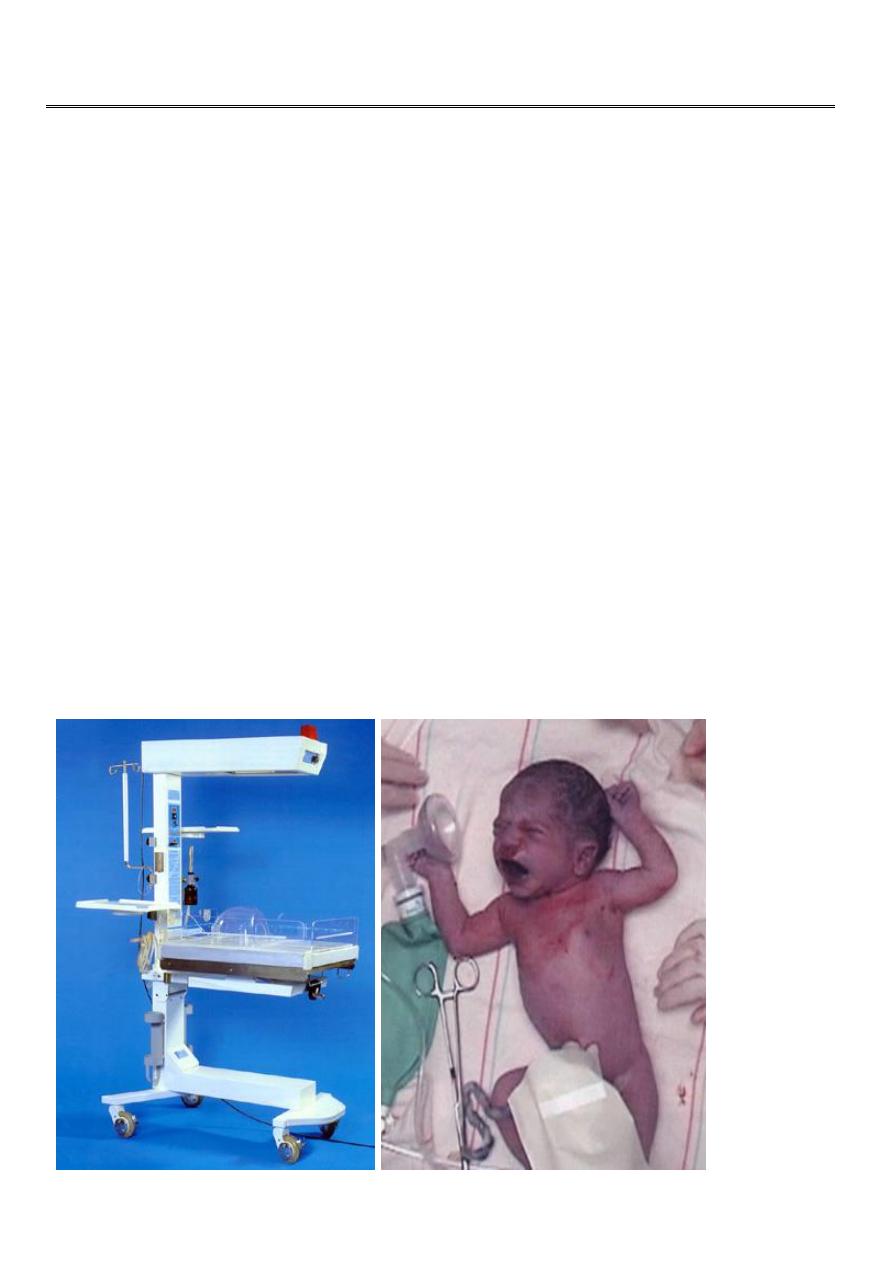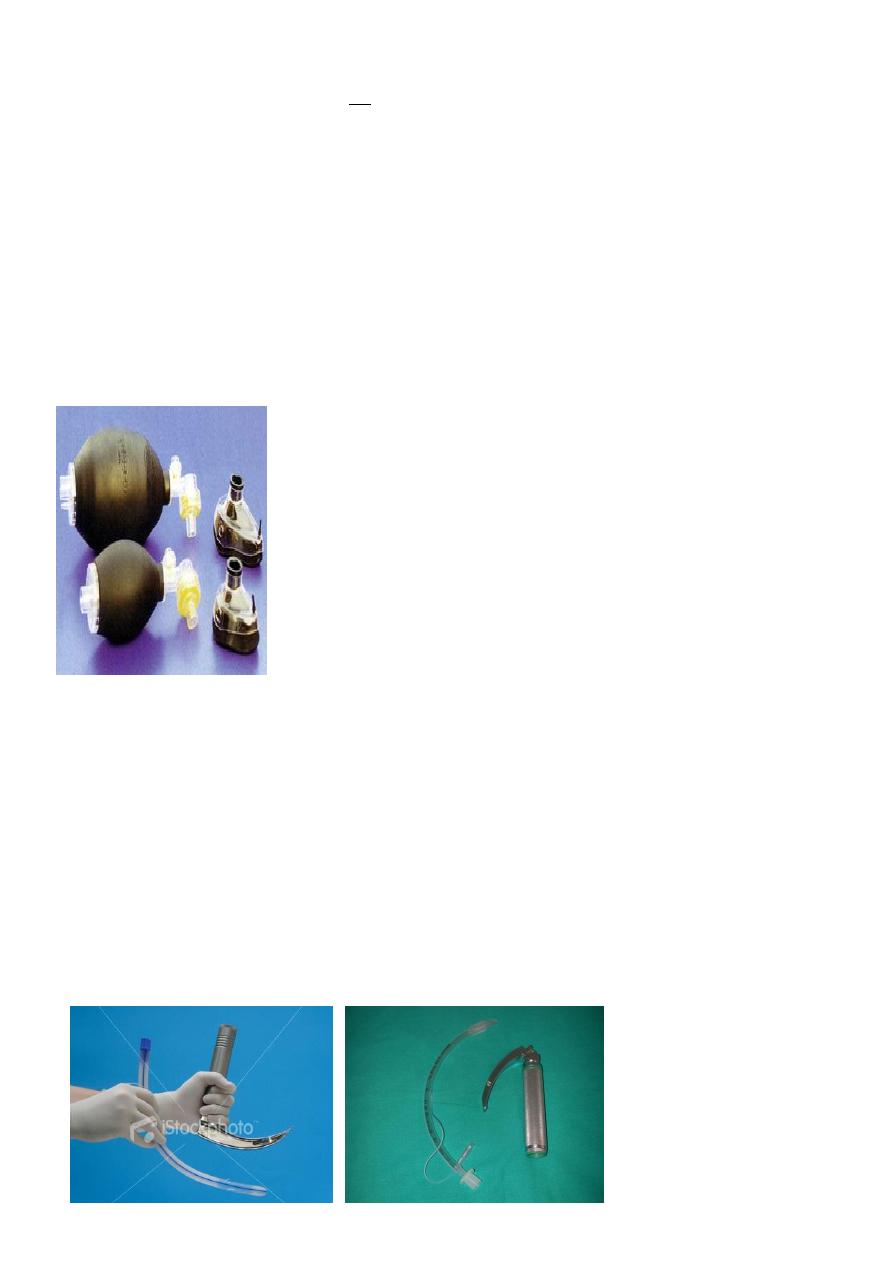
1
Fifth stage
Pediatrics
Lec-4
د.بسام
30/11/2015
Resuscitation of The Newborn Baby
The goal of resuscitation is :-
-To prevent morbidity & mortality associated withhypoxic-ischemic tissue injury ( brain,
heart, kidney), this can be achieved if adequate spontaneous respiration and sufficient
cardiac output can be re established early on.
Although the Apgar score is helpful in evaluating patients in need of attention, infants who
are born limp, cyanotic, apneic, or pulseless require immediate resuscitation before
assignment of the Apgar score.
Rapid and appropriate resuscitative efforts improve the likelihood of preventing brain
damage and achieving a successful outcome.
About 5-10% of newborn babies require active intervention to establish normal
cardiorespiratory function.
1- First of all the asphyxiated newborn baby should be put on a resuscitation trolley where
the baby put under a radiant heater to avoid hypothermia then drying up of the baby, the
head is positioned down & slightly extended, the airway is cleared by suctioning, and also
gentle tactile stimulation provided (slapping the foot or rubbing of the back).

2
If spontaneous respiration started and the cardiac output improved where the color of the
baby becoming pink, then there is no need now to go onto further steps of resuscitation,
but if these measures fails to improve the condition of the baby and the heart rate is < 100
/min so we need:-
2- Positive pressure ventilation with a 100% oxygen is given through a tightly fitted mask &
bag for 15-30 sec, subsequent breaths are given at a rate of 40-60 /min with pressure of 15-
20 cm water.
Successful ventilation is determined by good chest rise symmetric breath sounds, improved
pink color, heart rate of >100 /min, spontaneous respiration and improved tone. If no
response within 15-30 sec. the next step is:-
Ambu bag
Traditionally, the inspired gas for neonatal resuscitation has been 100% oxygen.
Resuscitationwith room air (or 30%) is equally effective and may reduce the risk of
hyperoxia, which is associated with decreased cerebral blood flow and generation of
oxygen free radicals. Currently 100% O
2
is recommended. Room air (or 30%) may become
the preferred initial gas for neonatal resuscitation in the future.
3- Insert an endotracheal tube and start to push an oxygen through the tube by an ambu
bag, if after 15-30 sec of doing that & the baby does not improve: (no spontaneous
respiration, heart rateis < 100/min, no improvement in the color of the baby, so the next
step is:-

3
4- Starting chest compression (cardiac compression to improve circulation) the
compression is exerted to the lower third of the sternum at a rate of 120 per min. the ratio
of compression to ventilation is 3:1 simultaneously the color, the heart rate the respiration
and muscle tone should be assessed, if the baby did not respond after 15- 30 sec of chest
compression & oxygen supply through an endotracheal tube then:-
5- An intravenous drugs are used after an insertion of an intravenous (usually umbilical)
catheter and as follows:-
1. Epinephrine 1/10000 (0.1-0.3) ml/kg IV or intratracheal is given for asystole or for
failure to respond to 30 sec of combined resuscitation and the heart rate is < 60/min,
this can be repeated every 5 min .
2. Volume expanders 10 - 20 ml/kg of (normal saline, blood, 5% albumine, or ringers
solution) should be given for hypovolemia,pallor,E.M dissociation (weak pulses with
norml heart rate), history of blood loss, suspicion of septic shock, hypotension or in poor
response to resuscitation.
3.
Sodium bicarbonate (1-2meq/kg) should be given slowly in case of metabolic acidosis
and resuscitation is prolonged.
4. Calcium gluconate (2-4 ml/kg of 10% solution) if there is evidence of hypocalcemia.
5. Naloxone given in a dose of 0.1 mg/ kg repeated as needed when there is CNS
depression due to maternal narcotic analgesic administration during labor which will
results in respiratory depression & failure to initiate spontaneous respiration.
6. Dopamine or dobutamine may be given in a dose of 5-20 microgram / kg/ min. this drug
may be used in severe asphyxia when there is depressed myocardial function.
Poor response to ventilation during resuscitation may be due to:-
1.loosely fitted mask.
2.Poor positioning of the endotracheal tube.
3.Intraesophageal intubation.
4. Airway obstruction.
5. Insufficient pressure.
6. Pleural effusions.
7. Pneumothorax.
8. Asystole.
9. Hypovolemia.
10. Diaphragmatic hernia.
11. Prolonged intrauterine asphyxia.
